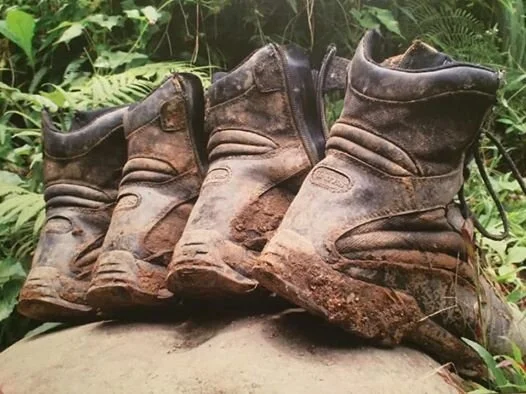FOOTWEAR BOOTS V SHOES
Why hiking in trail running shoes isn’t (usually) bad for our feet·
Trail running shoes vs hiking shoes: benefits and drawbacks·
How to know if hiking in trail running shoes makes sense for you·
Tips for transitioning from boots safely and comfortably
This a question that a trekker will ask prior to every trek. Boots can provide good foot protection, ankle support and shock absorption that trekkers will need. So why do most trekkers were trail running shoes?
QUICK ANSWERS.
Can you hike in trail running shoes? Yes - Especially if you have worked on strength and stability, not carrying a heavy backpack, hike in a warmer climate and are hiking on an established track. And all of this should be true if you have prepared for Kokoda.
Why do trekkers prefer hiking in trail hoes? They’re light, comfortable, breathable, quick-drying, and can reduce blisters.
Why do trekkers dislike hiking in trail running shoes? If they hike in cold or wet weather, they backpack with a really heavy pack, have a history of ankle injury, or just personal preference.
How to safely switch to hiking in trail running shoes? Start with short hikes. Do exercises to strengthen your glutes, core, and feet. Work up to longer hikes or backpacking with a heavy load.
Can you use trail running shoes for hiking? The answer is, yes, you can definitely hike in trail shoes. More and more trekkers are ditching the heavy boots and hiking in trail running shoes. Most trekkers, without a history of injury and with adequate strength, can hike safely and comfortably in trail running shoes or lightweight hiking shoes.
This is great if you have ever suffered with chronic blisters, hot and sweaty feet, or the swelling that can occur in heavy boots.
Most trail runners deal with the same terrain and a lot of the same demands that hikers do. And although they don’t usually carry heavy backpacks, their impact forces are high because of running’s dynamic style.
Trail running shoes are less bulky than hiking boots and they’re carefully designed for the rigors of trail travel. They’re typically designed with a sturdy sole to help protect feet from sharp rocks underfoot, a strong lugged sole for traction on rough terrain, and a focus on comfort for long hours on the track.
Equally important is to go for comfortable shoes as your first preference. Footwear should be slightly bigger than your normal size as your feet most likely will swell in the humidity and this can help prevent sore toes on the declines and discomfort if your feet swell. The Kokoda Track is harsh on boots; please do not trek in old or worn-out boots.
If you are carrying your Backpack in Trail Running Shoes
If you intend to hike with a heavy backpack, (hopefully not on Kokoda) or have weak ankles, then boots may be best for you. Alternatively, if you already hike in boots and are used to them, I would stick with them.
Less Weight on Your Feet
Some hiking boots can weigh double as much as trail running shoes. That’s a lot of extra weight to lift up and put down with every step! The average Kokoda trek is eight days and approx. 160kms. Shoes require slightly less energy and that’s extra energy you can spend hiking further, faster, or just happier.
More Breathable
Many hiking boots are waterproof or at least water resistant, which is intended to keep your feet dry when it’s wet outside or rains. But what about when it’s wet inside your shoe? Our feet can sweat up to 250ml per day and that moisture can’t escape very well from waterproof shoes. As well, there will be times when you will be required to walk through swamps, creeks and rivers where your feet and shoes will definitely get wet.
Most trail running shoes have breathable mesh uppers designed to let water both in and out very easily. This drastically reduces hot, itchy, sweaty feet. When you step in a creek or water, your socks will get wet, but in shoes, most cases they’ll be dry again in 30 minutes.
Quick Drying
Shoes have more breathability which means your wet shoes can dry faster and will usually be dry by morning. Putting cold wet boots after a night’s sleep can be demoralising. Trail running shoes can definitely handle a bit of mud, and they’ll dry faster than hiking boots.
Fewer Blisters and Hot Spots
Blisters are caused by friction between your foot and shoe and made worse by constant moisture. So, a stiff and heavy shoe rubbing on sweaty feet is bad news for many trekkers. However, a light breathable shoe often does not have these problems.
More Comfortable
With hiking shoes being lighter, drying quicker, less blisters this all equals more comfort trekkers.
Cons of Hiking in Trail Running Shoes
If you have a weakness or history of ankle injury, it’s to test out shoes prior to trekking. They’re sometimes not as durable as boots.Cheaper hiking shoes often aren’t as durable as cheaper hiking boots.
How to transition to hiking in trail shoes
If you currently hike in boots but are interested in making the switch, here are a few tips to get you started:
Start with short hikes and a light backpack.
There’s no reason you can’t work up to long hikes with a heavier pack and be successful in trail running shoes. Start with local day hikes before working up to an overnight hike.
Add strength training to your routine.
This is especially important for your hips/glutes, which control the stability of your legs and will help prevent falls.
Tips for Hiking in Trail Running Shoes
Feet swell after being walked on all day.Your hiking footwear should be at least ½ to one size bigger than your everyday shoes (allowing for differences between different brands’ sizing).
Wear thinner, lighter socks.
If you’ve been using thick hiking-specific socks with your heavy hiking boots, now is the time to try running socks with your running shoes. Ideally the lighter weight and more flexible fit of trail running shoes reduces the need for thick padded socks. I’m a big fan of Steigen Sockstrail socks (the sizing is unisex) for both running and hiking.It is advisable to wear your boots on the plane and bring essential items in your carry-on luggage. Bags can and do go missing, and if you have got your boots, medical supplies and any important items with you and your bag goes missing, this will make trekking much easier.
We have a great partnership with Anaconda & Mountain Designs ask our crew about this.



